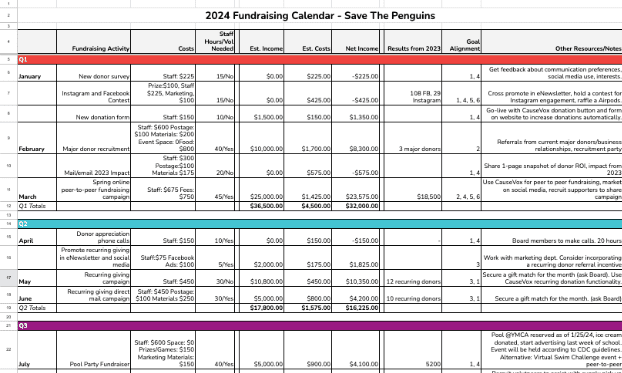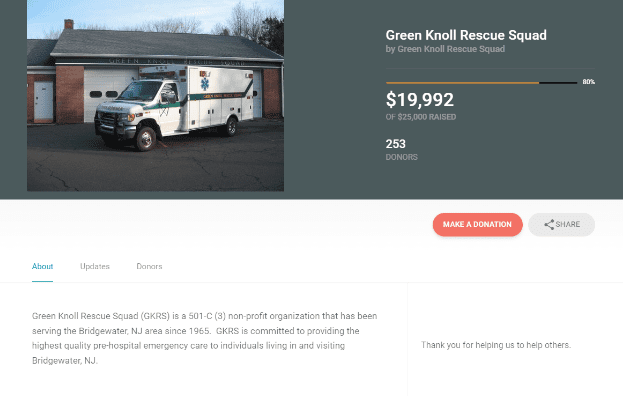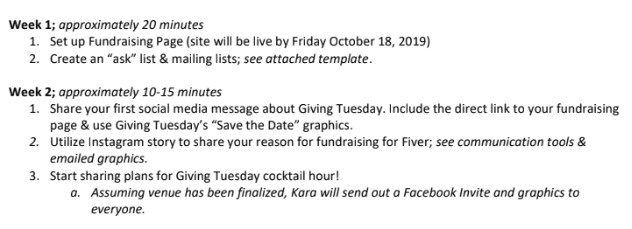What’s your plan for 2024? Whether fundraising went as you desired in 2023 or veered off your ideal path, it’s crucial to recalibrate for the upcoming year. The best way to do that is by crafting an annual nonprofit development plan for 2024.
What is an Annual Nonprofit Development Plan?
An annual nonprofit development plan (or fundraising plan) is simply a document that includes your fundraising goals for the year and how you plan to reach them. It includes the financial milestones you need to hit, the fundraising strategies you will use to reach those goals, and the timeline of when you plan to carry those strategies out.
Why Do You Need an Annual Nonprofit Development Plan?
As the highly accomplished Benjamin Franklin once said, “failing to plan is planning to fail.” If you’re responsible for bringing in the funds your organization needs to operate, you can’t take any chances of failing. Bearing this weight can cause a lot of anxiety and stress, but it doesn’t have to. If you invest a little bit of time to give yourself a plan to follow, you’ll be setting yourself up for success–which happens to rhyme with less stress!
To make the process as easy as possible for you, we’ve created a free fundraising goals and calendar template. We recommend filling this in while following the steps outlined below.
Download Your Fundraising Goals and Calendar Template:
How to Create Your Annual Nonprofit Development Plan
1. Budgeting and Resource Allocation
Establishing a robust budget that aligns with your overarching goals is not just a good financial practice; it’s a strategic move that amplifies the impact of every dollar spent.
Kickstarting the budgeting journey involves setting a comprehensive, year-long fundraising goal. This macro goal becomes the focal point to which all smaller goals should contribute. The key is to keep it concise while ensuring that every activity throughout the year plays a role in achieving this overarching objective.
To calculate your organizational goal, get a copy of the budget and follow these steps:
- Determine Expenses: Outline your expected spending, covering administrative, programming, and fundraising costs.
- Identify Guaranteed Income: Record the expected income from guaranteed, committed sources such as major gifts, recurring donations, pledges, and grants.
- Calculate the Funding Gap: Subtract the guaranteed income from the total expenses. The resulting figure will be the amount you need to raise through other fundraising activities during the upcoming calendar year.
For instance, let’s consider a total operating budget of $200,000. Anticipating $30,000 in government grants, $15,000 in foundation grants, and $40,000 in pledges already committed, you’d need to secure an additional $115,000 through other fundraisers to meet your organizational goal.
Following this systematic budgeting approach ensures that financial resources are strategically allocated to support your annual development plan.
Remember, the budget is not just about numbers; it’s your roadmap to success.
2. Evaluate Past Fundraising Strategies
Once you’ve calculated your organizational funding goal, you’ll want to think about the specific strategies you’ll use to get there. This begins with evaluating last year’s fundraising activities to assess their effectiveness.
So whether you had an official previous fundraising plan last year or not, start with reviewing your 2023 fundraising activities to gather insights. Use a spreadsheet to document all fundraising endeavors, assessing expenses, benefits, and key details for each. Like the budget, this evaluation isn’t just about numbers; it’s a vital step in determining your ROI, and helping you make informed decisions about repeating or refining strategies. Consider all income sources, including individual donations through various channels.

As you delve into the spreadsheet, reflect on the effectiveness of your 2023 fundraising approaches, acknowledging any wins, losses, or areas for improvement. Decide which ones you definitely want to repeat in your plan for 2024, as well as which ones you’d like to modify or improve.
3. Measuring Success and Adjusting Strategies
Measuring the success of your nonprofit’s annual development plan requires establishing realistic Key Performance Indicators (KPIs) that align with your goals. A specific example of a KPI could be looking at your donor retention rate. This metric tracks the percentage of donors from the previous year who continue to contribute in the current year.
For instance, if your organization had 1,000 donors in 2022 and, after implementing your annual development plan in 2023, 800 of those donors continued their support, your donor retention rate would be 80%.
Regularly reviewing and analyzing KPIs like donor retention rate provides valuable insights into the effectiveness of your fundraising strategies. If the rate is lower than desired, it may indicate a need to reassess engagement tactics, improve communication with donors, or refine existing fundraising activities.
4. Understanding Your Donors
When it comes to raising individual donations, one of the most important factors to consider as you choose your strategies is to make sure you have a solid understanding of who your target donor is. Think about it: you wouldn’t want to call a major donor and ask them for money without first getting an understanding of who they are and what they care about. This should also be true when considering your supporter network as a whole.
Consider doing these two exercises to get a clearer picture:
Donor Personas
Begin by creating detailed donor personas that represent different segments of your supporter base. Move beyond basic demographics to understand motivations, interests, and communication preferences. Picture a passionate advocate valuing social impact or a digital-savvy donor who prefers online engagement. Developing these personas offers nuanced insights into the diverse motivations driving your donors.
Data and Analytics
Tap into the power of data and analytics to segment and target your donors effectively. Analyze past giving patterns, contribution frequency, and preferred donation channels. Identify key touchpoints and interactions that resonated most with your donors. This data-driven approach allows you to tailor your outreach efforts, aligning them with the preferences and behaviors of different donor segments.
5. Diversifying Fundraising Strategies
Armed with a comprehensive understanding of your donors and an idea of which past fundraisers you’d like to repeat, you can now choose any new and improved strategies you’d like to implement for 2024.
While you make these decisions, we encourage you to embrace diverse fundraising channels. The fundraising landscape has evolved, which means you need to be prepared to offer an abundance of options beyond traditional methods like direct mail. The myriad of possibilities in fundraising today aren’t just extensive; they’re advantageous.
If you need ideas, we’ve compiled a list of 200 fundraising ideas to pull from!
As you consider which fundraising activities you want to implement in 2024, make sure you are setting specific and measurable goals aligned with your organization’s mission.

(Our fundraising calendar template)
Compile a comprehensive list of campaigns you intend to run, specifying when they are scheduled to occur. Draw from your insights of donor trends and from your understanding of your donor base to shape your annual plan. For example, if donors are less likely to attend in-person events in the summer, consider focusing on peer-to-peer campaigns or virtual events during that period.
When outlining each fundraiser, make use of the fundraising calendar to maintain a balance—ensuring enough activities to meet budgetary needs without overstretching your resources. To cover your bases, include key details such as the type of fundraising activity, anticipated revenue, marketing costs, deadlines, intended audience, and additional notes.
6. Ensuring Long-Term Sustainability
Of course, as you build your annual development plan, you want to set yourself up for success beyond just 2024. You want to make sure that you are planting the seeds for future success as well. Ensuring the long-term sustainability of your organization doesn’t happen in one day; it’s a journey. Luckily, we’ve curated some practical strategies that’ll let you embark on this journey with confidence:
Diversify Funding Sources
Let’s face it; relying on a single funding source is a bit like putting all your eggs in one basket. To give your organization a more stable footing, consider diversifying your funding streams. Think of it as planting different seeds in your fundraising garden – grants, corporate partnerships, and individual giving. This diversity not only weathers storms but allows your organization to bloom in various seasons.

(Green Knoll Rescue Squad’s crowdfunding campaign on CauseVox)
Endowment Building
Building an endowment is like giving your organization a financial safety net. Think of it as a financial cushion that allows you to dream big and plan for the long term. Encouraging donors to contribute to an endowment fund sets the stage for a lasting impact, providing stability during uncertain times and empowering your organization to reach new heights.
Strategic Partnerships
Picture your nonprofit as part of a community of superheroes, each with unique strengths. Forge strategic partnerships with like-minded organizations, businesses, and community stakeholders. Together, you’re not just amplifying your impact; you’re creating a support network that ensures everyone rises. It’s a win-win situation that turns collaboration into a powerful tool for sustainability.
Capacity Building
The backbone of any superhero team is its skills and capabilities. Invest in your team’s growth and development – a well-equipped team is your organization’s secret weapon. From upgrading technology to enhancing operational efficiency, this investment ensures that your nonprofit not only tackles challenges but does so with finesse and adaptability.
7. Building Donor Relationships
As you plan to carry out your fundraising strategies for the year, remember that how you communicate your fundraising needs with your donors is crucial.
Building meaningful connections with donors is an art and a science. In the dynamic world of philanthropy, technology acts as a bridge, bringing your organization closer to its supporters. Utilize this digital toolbox to share stories that resonate, celebrate achievements, and express gratitude for the invaluable role each donor plays in making a positive difference.
Let’s embrace building donor relationships with the tools at our disposal. Through genuine, timely, and impactful communication, ensure that each donor feels not just like an ATM but an integral part of the transformative narrative your organization is crafting. Be strategic in your communication by aligning your outreach with your calendar of fundraising activities.
Personalized Communication
Aim for personalized communication with your donors. Craft messages that speak directly to the motivations and interests of the specific donor personas you created. Whether through personalized emails, targeted campaign appeals, or strategic social media content, the goal is to make your message relatable. Taking the time to do this demonstrates that you recognize and value each donor’s unique contributions.
Successful Development Planning
Drawing inspiration from real-world success stories, we often turn to the exceptional example of the Fiver Children’s Foundation. Their outstanding organization shines, thanks to the thoughtful planning that guided their year-end peer-to-peer campaign execution.

(Referencing Fiver’s peer-to-peer toolkit, here’s a snapshot of the first two weeks of their campaign)
By taking lessons learned from the previous year, meticulously mapping out timelines, and documenting key dates for each phase of their initiatives, Fiver paved the way for success. This strategic approach ensures that every move has a purpose, contributing seamlessly to the overarching campaign goals. Their dedication to planning has not only streamlined their efforts but has been a driving force behind their accomplishments, underscoring the significance of careful and intentional preparation.
Your Turn!
Ready to embark on your journey to fundraising success? Your organization’s success story begins with a clear plan – start crafting yours today!
Download Your Fundraising Goals and Calendar Template:
Editor's Picks
Ultimate Guide To Peer-to-Peer Fundraising
Customer Story: Spur Local Raises Over $1M With Their Give Local Campaign
Fundraising Strategies for Nonprofits: Craft the Best Approach for Your Organization
Create a Killer Fundraising Plan - Best Practices, Strategies, & Downloadable Template



